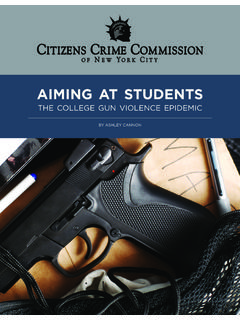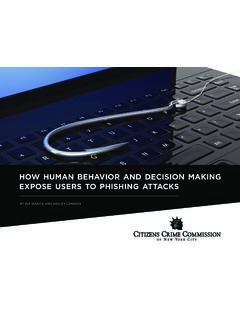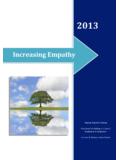Transcription of Lesson Plan: A Student’s Guide to Using Social Media Safely
1 A Student s Guide to Using Social Media Safely Lesson Plan Copyright 2015 Citizens Crime Commission of New York City, Inc. All Rights Reserved. Page 1 of 7 Lesson Plan: A Student s Guide to Using Social Media Safely Objective: To have students identify harmful and violent Social Media content they witness, experience, and post. This Lesson aims to provide students with action steps on how to handle such posts and avoid or resolve conflicts without causing harm to oneself or others. This issue is of great importance as this harmful content creates real world conflicts and violence among youth.
2 Further, law enforcement, employers, schools and colleges, among others, use Social Media to monitor youth and inform decisions, which can lead to arrest, being fired from a job, being suspended or expelled from school, and/or denied admission to college or a scholarship. Introduction (3-5 minutes): Introduce today s topic of Social Media use and how it affects life both on- and off-line. For example How many of you use Social Media ? What do you generally use it for? Have students identify positive and negative impacts of Using Social Media .
3 What are some of the pros and cons of Using Social Media ? What do you like about Social Media ? What don t you like? How do you feel about what happens on Social Media ? How do things on Social Media impact your life offline? o NOTE: Teens report that Social Media has both positive and negative impacts on their lives. Positive examples include teens feeling better about themselves, increased sympathy for others, and increased self-confidence; however, negative outcomes include problems with parents, anxiety from posted content ( pictures/videos), friendships ending, and face-to-face arguments.
4 O If students have not brought up negative impacts such as fights, arrests, violence, etc. resulting from Social Media , ask them about these consequences. Youth use Social Media to express a range of behaviors and emotions. While some of these behaviors and experiences are common among the general teen population face-to-face arguments, friendships ending, getting into trouble at school high-risk youth also use Social Media to provoke physical violence. This behavior is exhibited in a variety of ways: posting orders of protection that identify complainants to intimidate informants; posting fight videos to shame rivals; posting surveillance photographs of rivals they intend to attack/shoot; instigating conflicts by posting photographs of themselves in front of a rival s apartment building or turf; blatant posts discussing serious violent events; incoherent and emotional arguments between rivals; obvious promotion of gang activity.
5 And incessant taunting of rivals. An on-going cycle of A Student s Guide to Using Social Media Safely Lesson Plan Copyright 2015 Citizens Crime Commission of New York City, Inc. All Rights Reserved. Page 2 of 7 violence is created as youth instigate, react, and retaliate to content posted on Social Media . Do you ever witness or experience people fighting online or posting something to make other people mad? Have you ever seen pictures/videos of teens with guns, drugs, or wads of money? o Follow up with asking them why they think this is happening.
6 How do they feel when they witness or take part in this harmful behavior? Highlight behaviors that might influence the positive and negative outcomes. o How does someone s behavior influence a negative/positive situation, give an example of provoking an argument or ignoring a nasty post, etc. For example, if someone comments you re ugly on someone s picture, that will most likely have a negative effect, where saying you look nice will have positive effects, and not saying anything will (most likely) have neutral outcomes.
7 Ask students, what is a situation where not saying something would be positive or negative instead of neutral? Harmful and Violent Social Media Posts (5-10 minutes): Begin to delve deeper into the problem behaviors happening online specifically violence, criminal activity (guns, fight videos, drugs, wads of cash, etc.), harassment, meanness, bullying , etc. by giving students more information on today s topic. Ask students to identify what their biggest problems are on Social Media . If students don t identify violence, criminal behavior (guns, assaults, threats, mobbing1, wads of cash, drugs, etc.)
8 , bullying as big problems, ask them why these are not problems and stress the serious harm these types of posts can bring to themselves, people they care about, and others. o For example: have you ever seen people post statuses referencing another person, either by name or not? Have you ever witnessed someone threaten or harass someone on Social Media ? Has anyone liked or shared a fight video? How can this be harmful to you and others? Inform students on how police, employers, schools, and colleges all use Social Media to monitor youth and inform decisions about their futures.
9 Posting inappropriate content online can get you expelled, suspended, fired, hurt, killed, or arrested. 1 For the purposes of this curriculum, mobbing is defined as when a group of youth is mobilized to a specific location and they travel together down a street, through a park, subway station, or store. Mobbing is a way for crews to promote their image by projecting their strength, size, toughness and power, and a means to intimidate others. Videos of youth mobbing often exhibit them engaging in criminal activities such as theft, vandalism, weapons possession, harassment, and assault, among others.
10 A Student s Guide to Using Social Media Safely Lesson Plan Copyright 2015 Citizens Crime Commission of New York City, Inc. All Rights Reserved. Page 3 of 7 o Social Media activity is seen by everyone in a user s network (and sometimes the entire public), allowing people to re-post/share posts, causing the posts to be seen by even more people. Police can very easily become aware of posts involving criminal activity, and have used Social Media as evidence against youth in prosecutions. o Deter youth from engaging in criminal activity both on- and off-line.



